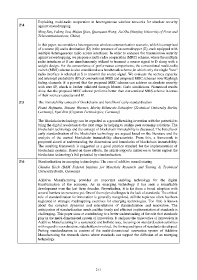Page 227 - Proceedings of the 2017 ITU Kaleidoscope
P. 227
Exploiting multi-radio cooperation in heterogeneous wireless networks for absolute security
P.4 against eavesdropping
Ming Sun, Yulong Zou, Mujun Qian, Quanquan Wang, Jia Zhu (Nanjing University of Posts and
Telecommunications, China)
In this paper, we consider a heterogeneous wireless communication scenario, which is comprised
of a source (S) and a destination (D) in the presence of an eavesdropper (E), each equipped with
multiple heterogeneous radio access interfaces. In order to enhance the transmission security
against eavesdropping, we propose a multi-radio cooperation (MRC) scheme, where the multiple
radio interfaces at S are simultaneously utilized to transmit a source signal to D along with a
weight design. For the convenience of performance comparisons, the conventional multi-radio
switch (MRS) scheme is also considered as a benchmark scheme, in which only the single "best"
radio interface is selected at S to transmit the source signal. We evaluate the secrecy capacity
and intercept probability (IP) of conventional MRS and proposed MRC schemes over Rayleigh
fading channels. It is proved that the proposed MRC scheme can achieve an absolute security
with zero IP, which is further validated through Monte- Carlo simulations. Numerical results
show that the proposed MRC scheme performs better than conventional MRS scheme in terms
of their secrecy capacity and IP.
P.5 The immutability concept of blockchains and benefits of early standardization
Frank Hofmann, Simone Wurster, Moritz Böhmecke-Schwafert (Technical University Berlin,
Germany), Eyal Ron (Cryptom Technologies, Germany)
The blockchain technology can be regarded as a groundbreaking invention with the potential to
bring the digital revolution to the next stage by helping to realize peer economy solutions. The
blockchain technology and the concept of blockchain immutability is discussed. The benefits of
early standardization of the blockchain technology are argued based on the literature and the
analysis of the central blockchain immutability characteristic. From this, a framework is
proposed aimed at understanding the dimensions and boundaries of blockchain immutability.
The resulting framework is suggested as a good practice standard for the implementation of
blockchain systems. Based on these efforts, the article supports initiatives to better exploit the
blockchain technology's full potential by standardization.
P.6 Standardization in emerging technologies: The case of additive manufacturing
Claudia Koch (BAM Federal Institute for Materials Research and Testing & Technical
University Berlin, Germany)
Additive Manufacturing provides an important enabling technology for the digital
transformation of the economy. As an emerging technology it has seen a remarkable
development over the last three decades. Nevertheless, it is far from a broad adoption with
several barriers to overcome yet. One of the major challenges is the lack of standards. The critical
role of standardization for innovation is generally recognized, still the topic too often has been
neglected in strategic roadmapping exercises for emerging technologies. Too little is known
about the complex dynamics and interrelations of standardization and innovation. The
anticipation of standardization needs and the timely and efficient implementation of standards is
challenging. This paper aims at contributing to a better understanding of the role that standards
play in the multi-dimensional system of innovation. It analyzes the trajectories of innovation in
Additive Manufacturing in a systematic and holistic way, focusing on standardization activities
with regard to coordination, stakeholders involved, the timing and types of standards developed.
Putting standardization in context of the multi-dimensional innovation system of Additive
Manufacturing the research shows where standards can support the diffusion of an emerging
technology.
– 211 –

